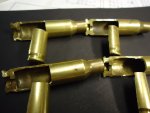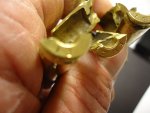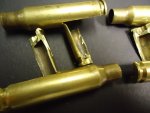I've received several deliveries of once fired 308 brass (most of it is LC-13; some of it was mixed headstamp /w mostly LC-10 and a lesser amount of Win. and the balance various other makes).
I started off loading the LC-10 /w 168 gr. SMK , 150 gr Hornady FMC and pretty much starting loads of H4895 and BL-C2. The gun is an Armalite /w 20" chrome lined std weight barrel.
On my first load of the LC-10 (approx. 50 rds.) I had two partial head separations (faint bright ring about 1/2" up from the case head and a definite crack about half way around the case). The rest of the cases looked OK (no bright ring showing beginning of incipient separation) so I've loaded them 2 more times (ie. they have been fired now a total of 4 times). Still no outward appearance of any separation but I took a stiff wire with a hook bent at one end to prob the inside of the cases and can definitely feel a ring of thinning above the base. I sectioned some of them with a cut off wheel and the case thinning is very apparent.
Wondering if the beginnings of case separations were already present in the once fire brass I received, with a wire probe, I checked a number of cases that I had only de-primed and cleaned. I could feel the beginning of a ring of thinning in probably 20% of the LC-13, 10% in the LC-10 and none in the Win. I sectioned some of the cases and confirmed what the wire probe found.
I realize this brass was probably fired in a MG so I'm guessing this case stretching is pretty normal when you get once fired.
I gather that lots of guy on this forum shoot a lot of once fired brass. My question is: do you inspect all of your newly acquired once fired brass with a wire probe to detect case thinning and separate the brass in to lots for different uses (or at least different numbers of reloads)?
I started off loading the LC-10 /w 168 gr. SMK , 150 gr Hornady FMC and pretty much starting loads of H4895 and BL-C2. The gun is an Armalite /w 20" chrome lined std weight barrel.
On my first load of the LC-10 (approx. 50 rds.) I had two partial head separations (faint bright ring about 1/2" up from the case head and a definite crack about half way around the case). The rest of the cases looked OK (no bright ring showing beginning of incipient separation) so I've loaded them 2 more times (ie. they have been fired now a total of 4 times). Still no outward appearance of any separation but I took a stiff wire with a hook bent at one end to prob the inside of the cases and can definitely feel a ring of thinning above the base. I sectioned some of them with a cut off wheel and the case thinning is very apparent.
Wondering if the beginnings of case separations were already present in the once fire brass I received, with a wire probe, I checked a number of cases that I had only de-primed and cleaned. I could feel the beginning of a ring of thinning in probably 20% of the LC-13, 10% in the LC-10 and none in the Win. I sectioned some of the cases and confirmed what the wire probe found.
I realize this brass was probably fired in a MG so I'm guessing this case stretching is pretty normal when you get once fired.
I gather that lots of guy on this forum shoot a lot of once fired brass. My question is: do you inspect all of your newly acquired once fired brass with a wire probe to detect case thinning and separate the brass in to lots for different uses (or at least different numbers of reloads)?







